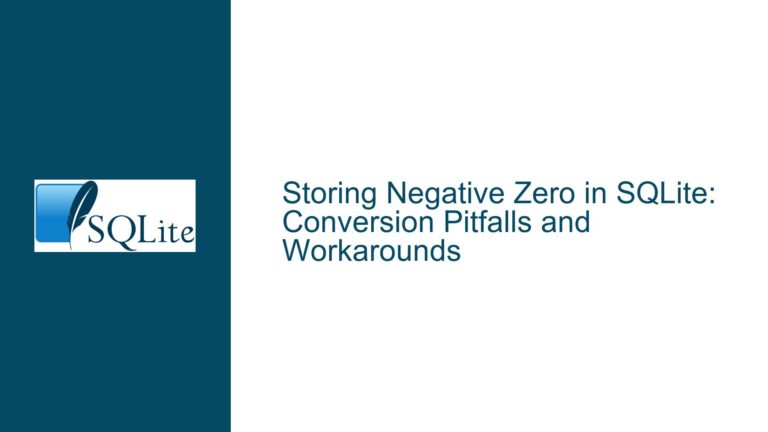Handling Dynamic Table Names and Schema Design in SQLite
Dynamic Table Name Placeholders in SQLite: Limitations and Workarounds
SQLite, as a lightweight and embedded database, is designed for simplicity and efficiency. However, one of its limitations is the inability to use placeholders for table names in SQL statements. This limitation arises because SQLite requires a complete query plan before execution, which includes knowing the exact table and column names involved. Placeholders for table names would prevent SQLite from generating this plan, as the table structure could vary dynamically.
In scenarios where you need to insert data into multiple tables with similar schemas, such as storing financial stock data for different tickers, this limitation can be frustrating. For example, if you have 100 tables named first_table, second_table, and so on, you might want to loop through them programmatically and insert data without hardcoding each table name. Unfortunately, SQLite does not support syntax like INSERT INTO ? VALUES (?,?,?) where the table name is a placeholder.
To work around this limitation, you must construct the SQL query string dynamically in your application code. For instance, in Python, you can use string formatting to build the query string with the appropriate table name before executing it. Here’s an example:
import sqlite3
conn = sqlite3.connect('./stocks.db')
c = conn.cursor()
table_name = 'first_table'
numbers = [111, 222, 333]
# Dynamically build the query string
query = f"INSERT OR IGNORE INTO {table_name} VALUES (?,?,?)"
c.execute(query, numbers)
conn.commit()
This approach allows you to loop through multiple tables and insert data without repeating code. However, it also introduces potential risks, such as SQL injection if the table names are not sanitized. Always ensure that table names are validated or hardcoded in your application logic to mitigate this risk.
The Pitfalls of Using Multiple Tables with Identical Schemas
While the dynamic table name workaround solves the immediate problem, it often indicates a deeper issue with the database schema design. Using multiple tables with identical schemas, such as one table per stock ticker, is generally considered an anti-pattern in relational database design. This approach can lead to several problems:
Inefficient Querying: SQLite is optimized for querying data within a single table using indexes. When you split data across multiple tables, you lose the ability to perform efficient cross-table queries. For example, if you want to calculate the average closing price across all stocks, you would need to query each table individually and combine the results in your application code, which is far less efficient than a single query.
Storage Overhead: SQLite allocates storage in pages, and each table or index consumes at least one page. If you have hundreds of tables, each with a small amount of data, you waste significant storage space due to partially filled pages. This inefficiency also increases the size of backups and slows down database operations.
Maintenance Complexity: Managing multiple tables with identical schemas is cumbersome. Any changes to the schema, such as adding a new column, must be applied to every table individually. This increases the risk of errors and makes the database harder to maintain.
Limited Scalability: As the number of tables grows, the performance of operations that involve searching through table names (e.g., schema introspection) degrades. SQLite is not optimized for databases with thousands of tables.
Consolidating Tables and Optimizing Schema Design
To address these issues, you should consolidate multiple tables with identical schemas into a single table and use an additional column to differentiate the data. For example, instead of having separate tables for each stock ticker, you can create a single stocks table with a ticker column:
CREATE TABLE stocks (
ticker TEXT,
date TEXT,
open REAL,
high REAL,
low REAL,
close REAL,
volume INTEGER,
UNIQUE(ticker, date)
);
In this schema, the ticker column identifies the stock, and the date column ensures that each record is unique for a given ticker and date combination. This design allows you to store all stock data in one table while maintaining the ability to query data for individual tickers or perform cross-ticker analyses.
Benefits of a Consolidated Schema
Simplified Queries: You can now write queries that operate on all stocks or a subset of stocks without needing to dynamically construct table names. For example, to retrieve the closing price for a specific ticker, you can use:
SELECT date, close FROM stocks WHERE ticker = 'AAPL';To calculate the average closing price across all stocks, you can use:
SELECT AVG(close) FROM stocks;Efficient Indexing: SQLite can create a composite index on the
tickeranddatecolumns, which speeds up queries that filter by both fields. This is far more efficient than maintaining separate indexes for each table.Easier Maintenance: Schema changes, such as adding a new column, only need to be applied once. This reduces the risk of inconsistencies and simplifies database maintenance.
Reduced Storage Overhead: By consolidating data into a single table, you minimize the number of partially filled pages, leading to better storage efficiency.
Migrating from Multiple Tables to a Consolidated Schema
If you already have data spread across multiple tables, you can migrate to a consolidated schema by following these steps:
Create the New Table: Define the new consolidated table with the appropriate schema, including the
tickercolumn.Export Data from Existing Tables: Write a script to loop through each table, read the data, and insert it into the new table with the appropriate
tickervalue.Drop the Old Tables: Once the data has been migrated, drop the old tables to free up storage space.
Here’s an example of how you might perform the migration in Python:
import sqlite3
conn = sqlite3.connect('./stocks.db')
c = conn.cursor()
# Create the new consolidated table
c.execute('''
CREATE TABLE IF NOT EXISTS stocks (
ticker TEXT,
date TEXT,
open REAL,
high REAL,
low REAL,
close REAL,
volume INTEGER,
UNIQUE(ticker, date)
''')
# List of table names to migrate
tables = ['first_table', 'second_table', 'third_table']
for table in tables:
# Extract the ticker from the table name (assuming table names are like 'AAPL_data')
ticker = table.split('_')[0]
# Select all data from the old table
c.execute(f"SELECT date, open, high, low, close, volume FROM {table}")
rows = c.fetchall()
# Insert data into the new table with the ticker value
for row in rows:
c.execute('''
INSERT OR IGNORE INTO stocks (ticker, date, open, high, low, close, volume)
VALUES (?, ?, ?, ?, ?, ?, ?)
''', (ticker,) + row)
# Drop the old tables
for table in tables:
c.execute(f"DROP TABLE {table}")
conn.commit()
Advanced Considerations: Sharding and Views
In some cases, you may have legitimate reasons to split data across multiple tables or databases. For example, if you are storing data for different clients and need to ensure strict isolation, you might use separate SQLite files for each client. This approach, known as sharding, can be effective but comes with its own set of trade-offs.
Alternatively, you can use views to simplify querying. For example, you can create a view that filters data for a specific ticker:
CREATE VIEW aapl_stock AS
SELECT date, open, high, low, close, volume
FROM stocks
WHERE ticker = 'AAPL';
This allows you to query the view as if it were a table, while the underlying data remains consolidated in the stocks table.
Conclusion
While SQLite’s lack of support for table name placeholders can be inconvenient, it often highlights a need to rethink your database schema. By consolidating multiple tables with identical schemas into a single table and using additional columns to differentiate data, you can achieve a more efficient, maintainable, and scalable design. This approach not only simplifies your application code but also leverages SQLite’s strengths in indexing and query optimization.






